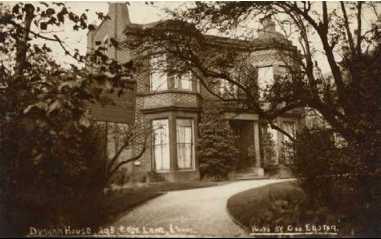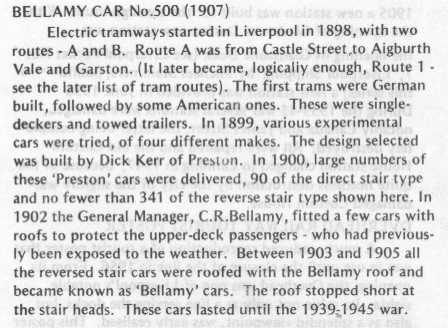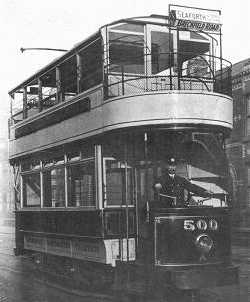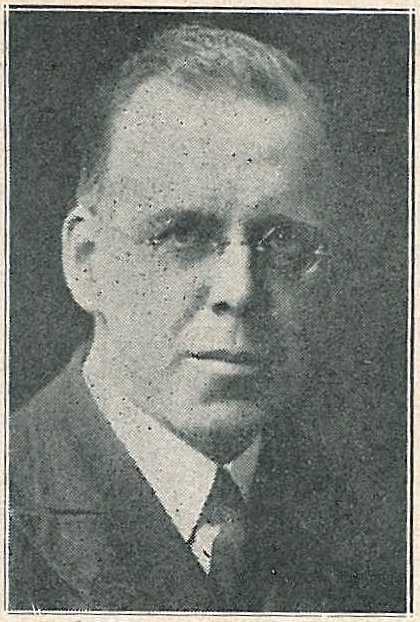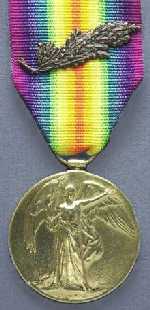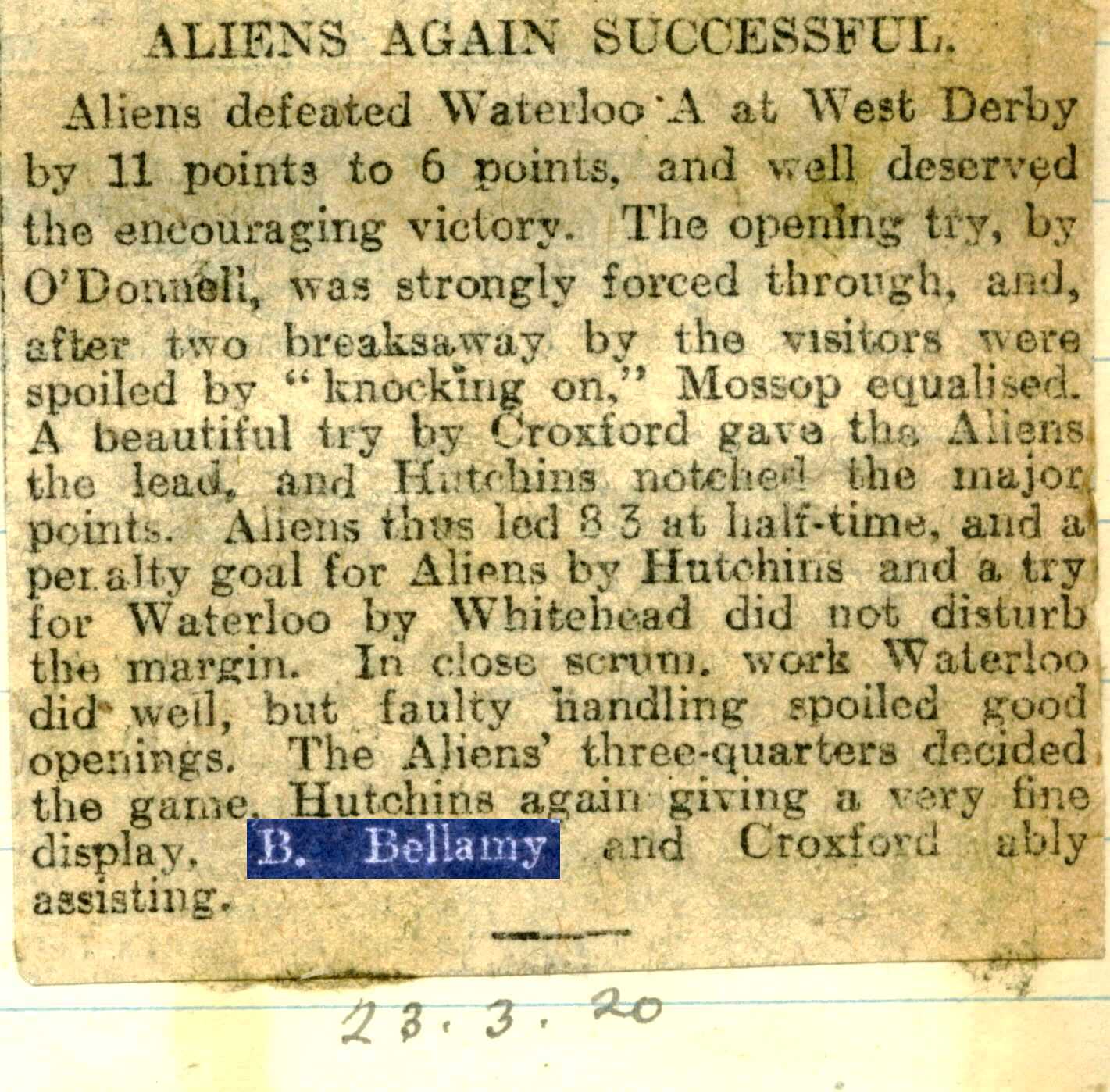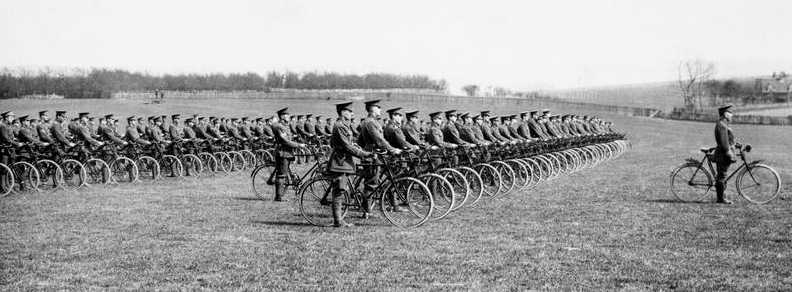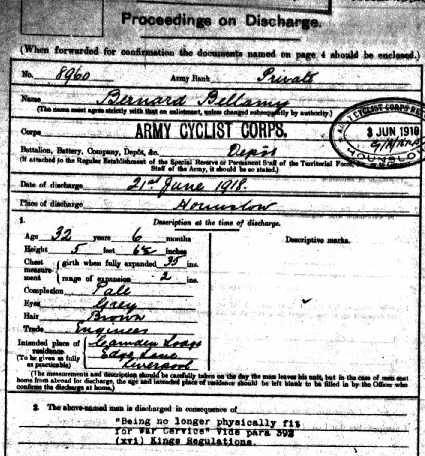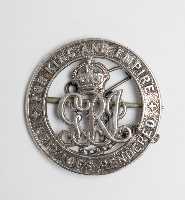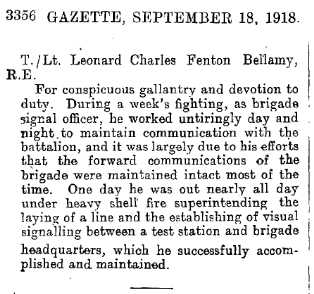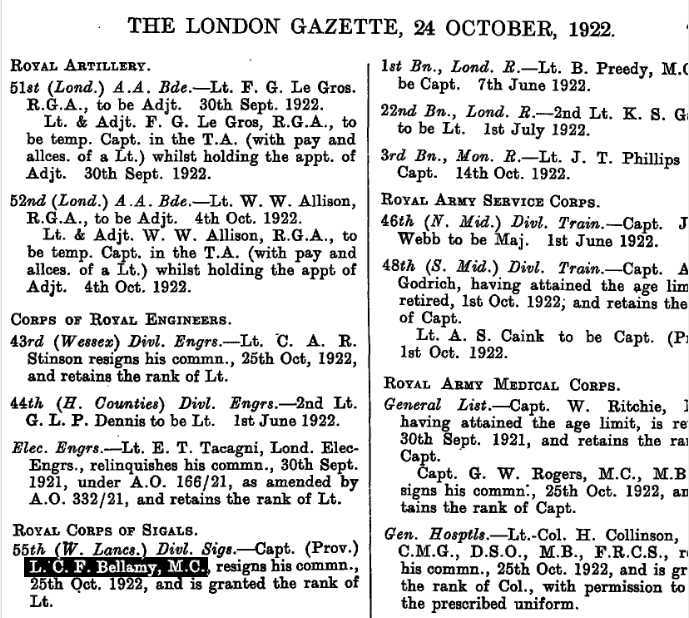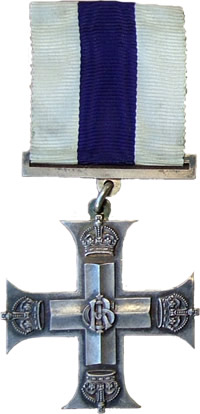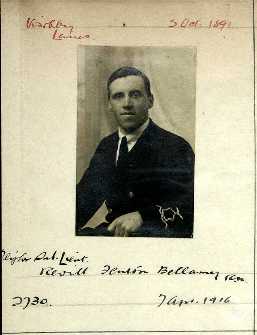Written and researched by David
Bohl,
with the kind help of the Wikitrees Bellamy entry and historians
worldwide.
The
Bellamy Brothers 1976 hit was "
Let
Your Love Flow" and the love
certainly flowed in this Alien
household
with seven brothers and two sisters occupying a large property on Edge
Lane, a few doors up from the now Devonshire Hotel. It was
certainly
a well-to-do family with two servants.
[Similar property two doors down
- LDS Church Archives]
Their father
Charles
Revill came to Liverpool as the
engineer in charge of public street
lighting and became the Manager of
Liverpool
Tramways
He encouraged his boys into the field of Electrical
Engineering,
which they did with great aplomb and all six of them had distinguished
service in the Great War.
Dudley(D.W.F) played
either side of the Great War and both Fenton(F.G) and Vivian(V.A.F)
played in the post-war
years, all of them served on rugby committees.
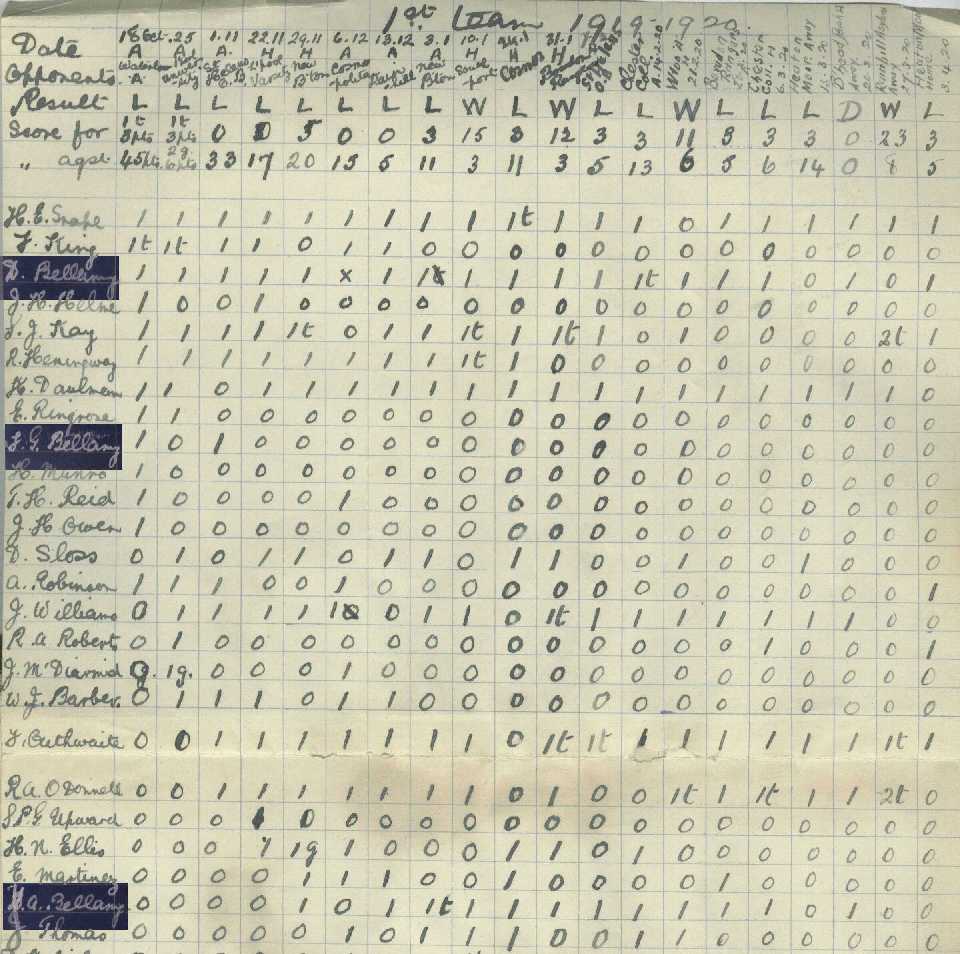

(Vivian Arthur Fenton,
b. 1889 Liverpool
d. 1942 Douglas, Isle of Man)
Vivian was born in Fazakerley 1889 and educated at Merchant Taylors in
Crosby. He received an Honours Degree in Electrical Studies through the
London
City and Guilds Institute.
He resided on the Isle of Man from 1912.With the outbreak of
war
he joined the Royal Naval Volunteer Force and
in 1915 was granted a temporary commission as a Lieutenant,
moving
down to
Pulham
St Mary in Norfolk
where he was appointed President for the
Royal Naval Airship
Association.

Pulham was one of the main British
airship stations, with more than 3,000 men on the base at the end of
the First World War. Initially it was used for airships that operated
patrols over the North Sea (such as the Coastal and Submarine/Scout
types) until
their areas were taken over by seaplanes.
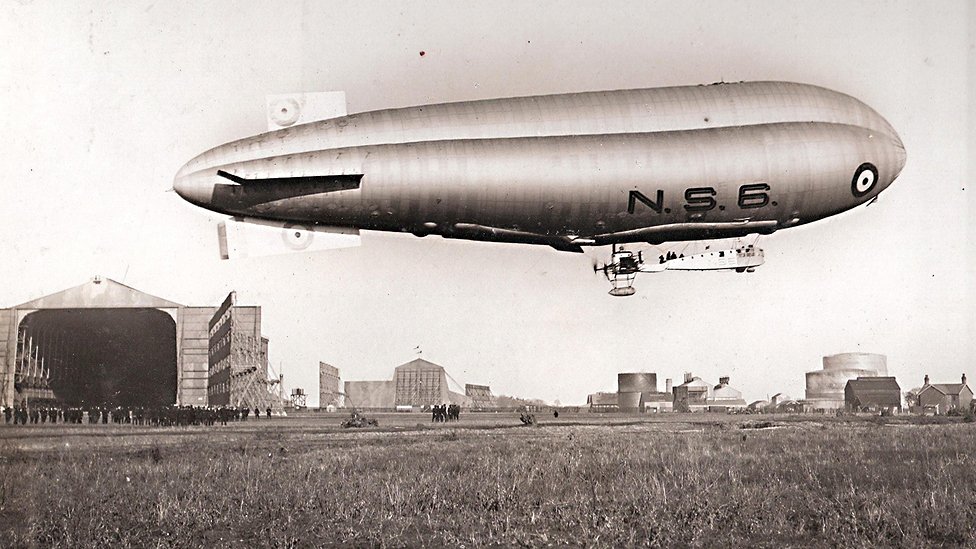
[Photo
by George Hamilton, Wakefield]
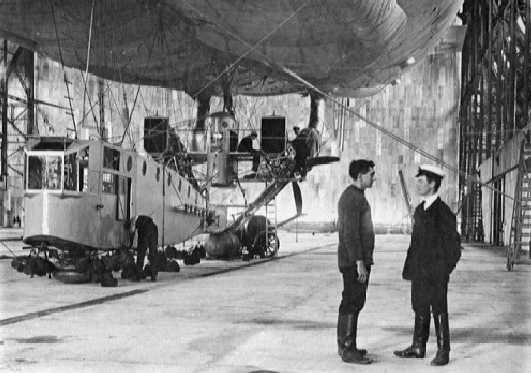
[Photo
NS11.org]
The
following Officers and Men have
been mentioned in Despatches -
for
zeal and devotion to duty
during the period from 1st July to
31st December, 1917
Lieut. Vivian
Arthur Fenton Bellamy, R.N.V.R.
(Apparently
he flew a dirigible back
from France with a broken backbone.)
He
was awarded the Air Force Cross in
the New Years Honours
|
|
|
|
Air
Force Cross
|
Victory
Medal
with Oak Leaf for Mentioned in Despatches |
On his return to civilian life he used
his experiences and knowledge to take out a
patent
in1920
FOR
IMPROVEMENTS IN APPARATUS FOR MIXING AIR AND GAS
IN AIRSHIP ENGINES
(PULHAM).
Vivian
Arthur Fenton Bellamy & Archer Ormonde
Binding
They were both
awarded AFC's at
the same time:-
Moving back to the Isle of Man in 1919 he became an electrical
contractor and formed a limited company in 1926. According to the
newspapers these were indifferent times for him with numerous
litigation processes, bankruptcy and a tragic motor accident.
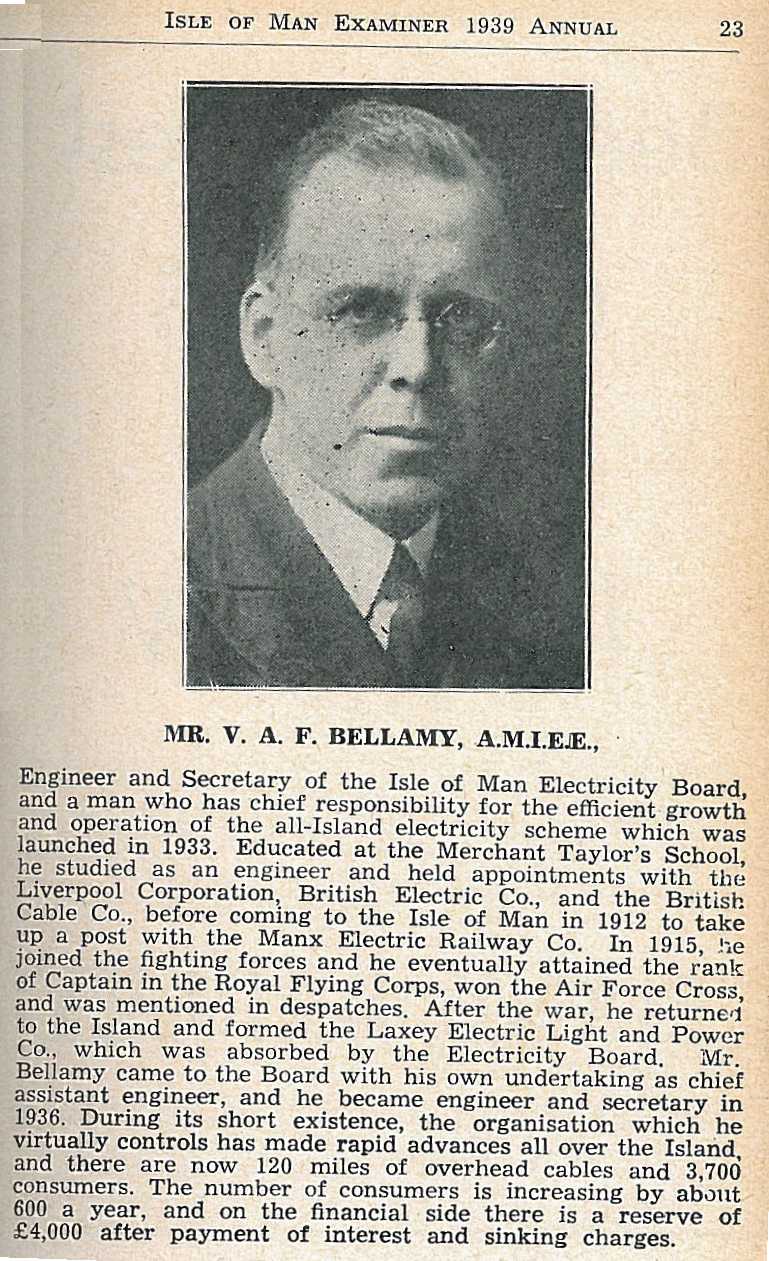
[Image courtesy of
Manx National
Heritage]
Vivian
passed away on the Isle of Man in 1942
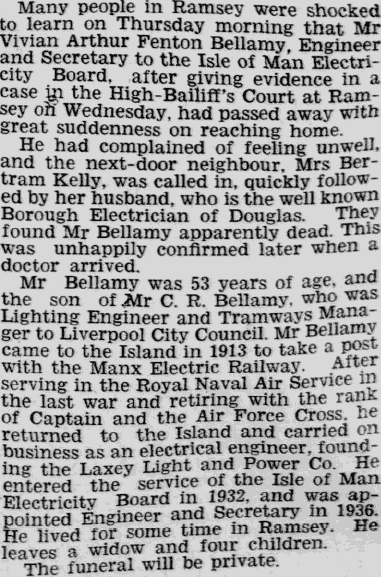
[Newspaper
Archive imuseum.im
- 17th July 1942]
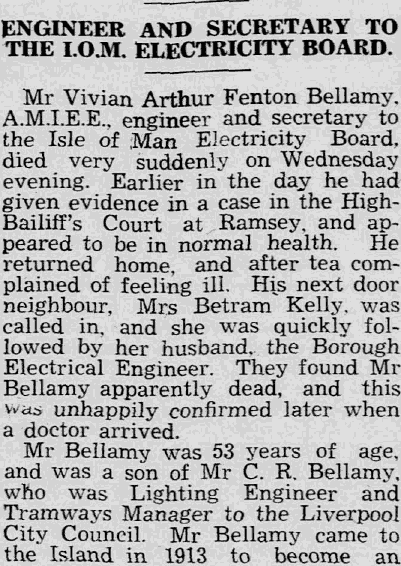
[Newspaper
Archive imuseum.im
- 21st July 1942]
(Fenton George, b. 1899
Liverpool d. 1986
Calgary, Canada)
Fenton
was born in Fazakerley 1899 and
was educated at Church of England Public Schools
in
Liverpool.
In the latter years of WW1 he joined up with the Royal Engineers and
fought in France with the Signals and went on the
North
Russian Relief
Expeditionary Force as a
dispatch rider in
Archangel.
After the war here he is playing rugby with his
brother Dudley:-
SEFTON
FAIL AT SOUTHPORT.
For the major portion of the
game at Victoria Park, where
Sefton
were the visitors, there was only one team in it. In the first half
Sefton were rarely out of their own territory. This was not so much the
result of Southport's play as of the inefficiency
of Sefton. Scott was
the first to get over, but the goal-kick was from an extremely
difficult angle, and J. Twynne was not to be blamed for failing. Before
the interval, Scott and Guest scored between the posts, and Gifford
easily added the extra points. Sefton did better in the second half,
Bellamy
grounding the ball behind the
uprights. Miller, however,
placed
wide. Irving put Southport further ahead with a drop goal, but Gifford
and Twynne failed from tries by Walker and Buck. In all departments
Southport were the cleverer side. Result: Southport, 23; Sefton 3.
Post 13/12/1920
Between
1924-26 he was working on the Isle of Man as a machinist for
Douglas
Trams.
Becoming an Associate of the Institute of Electrical Engineers he then
decided to further himself and emigrated to
Canada.
As we can see he was much travelled in his varied employment:-
- Hired Hand (at Jim Sharp's
in North Battleford, SK 1927-8) and
Farmer in Saskatchewan 1926-1936
- St. John's First Aid Man,
logging companies, Port Mellon, BC and
Vedder Crossing 1936-1937
- Industrial first Aid
Certificate Grade B earned 5 July 1939
- Machinist, Dominion Bridge,
Calgary AB 1936
- Tool & Die
Machinist, Canada Packers, Vancouver, BC 1938-1939
- Machinist, Swift Meats, Los
Angeles, CA 1939-41
- Machinist, Shell
Development, Emeryville, California 1941-1944
- Machinist, Tidewater Oil,
Avon, CA 1944-1957/8
- Lab Technician, Phillips
Petroleum, Avon, CA 1958-1964
In WW2 he was Assistant Chief Warden for the Civil Defense in Concord,
Calinfornia.
On retirement he returned to Calgary and only passed away in 1986.
His papers reside with Special Collections and Archives,
University Library, University of
California, Santa Cruz.
(Dudley William Fenton,
b. 1894 d.
1936 Nantwich)
Dudley was born in Kirkby 1893 and
educated in local public schools. He joined the club in October 1912
and played with some players who sadly lost their lives in WW1, such as
J.H.Weights,
R.G.Griffith
and
J.G.Williams.
Aliens- Griffiths, T. Jones, Weights,
Bellamy,
Rumjahn,
Croxford,
Ellis, Parry, Sloss, Roberts, A. Roberts, Kaye, Outhwaite, Ringrose,
Williams, Referee, Mr. F. H. Edwards.
Post 29/9/1913
Military
service started with the
Lancashire Hussars Yeomanry (perhaps he lived out of town in 1914) and
as a 2nd Lieutenant,
Kings Liverpool Regiment in 1915 he went on the British Expeditionary
Force. He transferred to the
Kings
African Rifles as an Officer in
1915
and fought at the Battle of
the Somme. With German East Africa (now Tanzania) still causing
problems he went out in 1918 and made the enemy lay down their arms in
November of that year.
After returning from
the forces he was elected to the Aliens Selection Committee, here he is
playing rugby with his
brother Fenton :-
NO
SCORING AT WEST DERBY.
Had
Fylde had their full complement in
their match with Sefton
at
West Derby, they would undoubtedly have carried off the honours. As it
was they battled throughout with thirteen men in a rather scrambling
game which ended in a pointless draw. Fylde are a fairly good side and
their superior weight aided them considerably in their uphill fight. In
the first half Martinez made Sefton's best effort, but Rothwell downed
him at the finish. On the other hand Wilkinson narrowly missed dropping
a goal for the visitors. In the second half, Fylde struggled gamely
with their depleted forces and twice were all but over the Sefton line.
The end came, however, without a solitary point being registered.
Bellamy,
Martinez, Streddon and
Stephens were prominent for Sefton,
while for Fylde, Rothwell at full-back was very sure and tackled well,
and Heap, Parkes, Hopewell, Robinson, and Wilkinson were the best of
the others.
Daily Post 20/12/20
By 1921 he had chosen the good life and taken on the ownership of
Sword Point Poultry Farm in Otley, Yorkshire. The
Committee
minutes note
"The
secretary proposed that a message be sent to Bellamy wishing him every
success in his new venture - and reminding him that his subscription to
the club is overdue."
In later life he
went back to the family profession and became a Sales Engineer for
North
Wales Power Company.
Dudley
passed away in Nantwich
at quite an early age with septicemia in
1936.
|
|
|
|
The
Allied Victory Medal
|
|
|
|
|
|
The
Lancashire Hussars Yeomanry
|
The
King's African Rifles
|
|
|
|
| The King's Liverpool
battalions should
have worn the White Horse of
Hanover cap badge but in honour of Lord Derby the King gave them
permission to wear the Derby crest of the Eagle and Child as well as
his family motto of Sans Changer (Without changing) |
(Bernard George Fenton,
b. 1886 Wirral d.
1953 Newcastle)
Bernard
was born in Liscard 1885, he
played a few games in the 1919-20 season.
Miltary career:-
- To 27th Divisional Cyclist
Company 7th June 1915
- The 27th DCC moved to
Salonika, Greece in December 1915
- To 8th Divisional Cyclist
Company on 25th April 1916
- To 3rd Corps Cyclist
Battalion 11th May 1916
"Cyclist
Battalions tended to be dispersed. Typically, they provided Corps
observation posts, traffic control parties and fatigue parties for most
of 1916 and 1917. In 1918 some were sent into the line in a dismounted
role. The XI Corps lost 230 out of 290 men at La Couture in April 1918
when they were deployed as infantry. The IX Corps Cyclists fought as
infantry at Meteren in April 1918 and at Fismes in May 1918. The VIII
Corps Battalion held a section of the line around Trotte in June.
Towards the end of the war, when they were once again used in their
originally intended scouting role during the final advance, the
Cyclist Battalions were split up between the leading Brigades to act as
scouts, usually one Platoon to a Brigade" (Owen on
1914-1918.invisionzone.com)
Bernard was subsequently badly injured in early 1918 and returned to
Blighty.
“For King and Empire
–
Services Rendered”
He
made a good recovery and became
Chief Engineering Draughtsman at the Chester Gas Company.
Bernard
passed away 1953 in Stoke
Hospital, Newcastle-on-Tyne.

L.C.F.Bellamy
(Leonard Charles Fenton,
b. 1884 Wirral
d. 1964 Reading)
Leonard
was born in
Liscard 1884 and
was educated at the Liverpool Institute High School. After an
apprenticeship at
Dick
Kerr and Co Ltd (English
Electric) he went out
to Burma in 1907 and rose to assistant manager of the
Rangoon
Tramways and Supply Co.
In 1910 he returned to take a post as assistant Manager, St
Helens
and District
Tramways Co. Ltd.
From 1912-1914 he was Borough Engineer and Tramway Manager, Ilkeston,
Notts.
During WW1 he served as 2nd Lieutenant with the Royal Corps of
Signals(55th West Lancs) and won the Miltary Cross at Gallipoli. (See
Horace Tolson's
campaign)
He returned in 1919, resigning his commission in 1922.
He moved to Kiln Lane, St Helens to become General
Manager of
St
Helens Corporation Tramways.
By 1924 he was appointed General Manager,
Hong
Kong Tramways
Ltd.,
An extract from the speech of the President of the Hong Kong Automobile
Association
Mr.
L. C. F. Bellamy said:
"I should like to refer to the Sai Kung Road project in the New
Territories. In his Budget speech on September 5th, 1929, the Colonial
Secretary called attention to the proposed Circular Eastern Road. The
wonderful possibilities of this enterprise have been stressed on many
subsequent occasions.... All members of this Association earnestly hope
that Government finances will soon render it possible to proceed with
the Sai Kung Road scheme and your Committee is of opinion that any
reasonable outlay in connection with the proposed road will prove a
sound Government investment."
Before WW2 he was active in the Boy Scouts Association of Hong Kong.
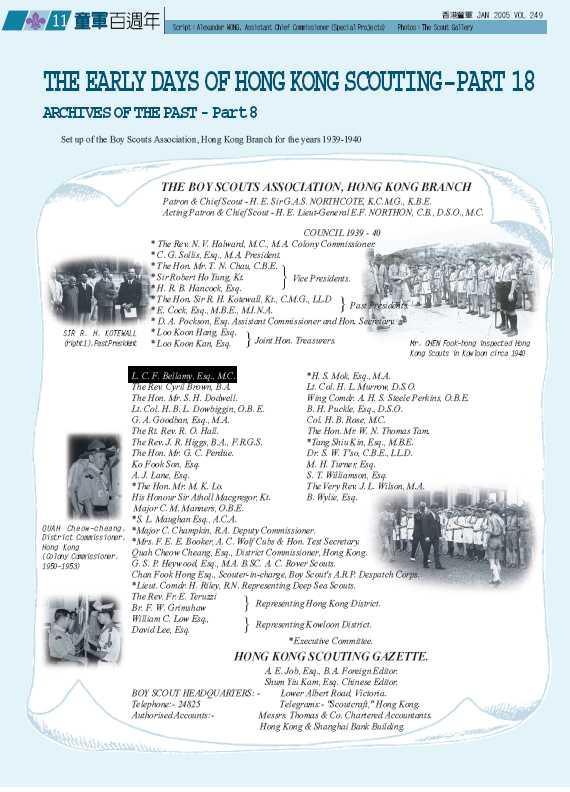
[Article
from the Hong Kong Scouting
Gazette 2005]
Hong
Kong Telegraph, February 3, 1941
The Scottish Society celebrates Burns Night in the Rose Room of the
Peninsula Hotel – there are about 250 members and guests
present.
While proposing the toast to 'the immortal memory'', Professor Walter
Brown of Hong Kong University speaks about Burns as a man and as a
poet, dwelling on his services to freedom
The dinner is served in traditional style with the Barley Bree and the
Haggis (piped to the Chieftain's table by the St. Andrew's Society
honorary pipers).
The Chieftain is SCMP journalist Ben Wylie and also in attendance are
past Chieftain G. D. R. Black, C. E. Terry (President of St. Patrick's
Society),
L.
C. F. Bellamy (Vice-President of St. George's Society),
Sir
Atholl MacGregor, French Consul-General Louis Reynaud, C. G. Perdue and
Dr. Selwyn-Clarke.
In WW2 he was interned by Japanese in Hong Kong 1941-45 (See also
Professor
Duncan Sloss
who was also interned)
The
Battle of Hong Kong was fought
December 8 to 25, 1941
Battle
of Hong Kong - Conflict & Dates:
World War II:
By Kennedy Hickman
Armies
& Commanders
Governor
Sir Mark Aitchison
Young Major General Christopher Maltby 14,000 men
Lieutenant
General Takashi
Sakai 52,000 men
Battle
of Hong Kong -
Background:
As the Second Sino-Japanese War
raged between China and Japan
during
the late 1930s, Great Britain was forced to examine its plans for the
defence of Hong Kong. In studying the situation, it was quickly found
that the colony would be difficult to hold in the face of a determined
Japanese attack. Despite this conclusion, work continued on a new
defensive line extending from Gin Drinkers Bay to Port Shelter. Begun
in 1936, this set of fortifications was modelled on the French Maginot
Line and took two years to complete. Centred on the Shin Mun Redoubt,
the line was a system of strong points connected by paths.
In 1940, with World War II
consuming Europe, the government in
London began reducing the size of the Hong Kong garrison to free troops
for use elsewhere. Following his appointment as Commander-in-Chief of
the British Far East Command, Air Chief Marshal Sir Robert
Brooke-Popham requested reinforcements for Hong Kong as he believed
even a marginal increase in the garrison could significantly slow down
the Japanese in case of war. Though not believing that the colony could
be held indefinitely, a protracted defence would buy time for the
British elsewhere in the Pacific.
Final
Preparations:
In 1941, Prime Minister Winston
Churchill agreed to dispatch
reinforcements to the Far East. In doing so, he accepted an offer from
Canada to send two battalions and a brigade headquarters to Hong Kong.
Dubbed "C Force," the Canadians arrived in September 1941, though they
lacked some of their heavy equipment. Joining Major General Christopher
Maltby's garrison, the Canadians prepared for battle as relations with
Japan began to falter. Having taken the area around Canton in 1938,
Japanese forces were well positioned for an invasion. Preparations for
the attack began that fall with troops moving into position.
The
Battle of Hong Kong
Begins:
Around 8:00 AM on December 8,
Japanese forces under Lieutenant
General Takashi Sakai began their attack on Hong Kong. Commencing less
than eight hours after the attack on Pearl Harbour, the Japanese
quickly gained air superiority over Hong Kong when they destroyed the
garrison's few aircraft. Badly outnumbered, Maltby elected not to
defend the Sham Chun River line at the colony's border and instead
deployed three battalions to the Gin Drinkers Line. Lacking sufficient
men to fully man the line's defences, the defenders were driven back on
December 10 when the Japanese overran the Shing Mun Redoubt.
Retreat
to Defeat:
The rapid breakthrough
surprised Sakai as his planners had
anticipating needing a month to penetrate the British defences. Falling
back, Maltby began evacuating his troops from Kowloon to Hong Kong
Island on December 11. Destroying harbour and military facilities as
they departed, the final Commonwealth troops left the mainland on
December 13. For the defence of Hong Kong Island, Maltby re-organized
his men into Eastern and Western Brigades. On December 13, Sakai
demanded that the British surrender. This was promptly refused and two
days later the Japanese began shelling the island's northern shore.
Another surrender demand was
rejected on December 17. The next
day,
Sakai began landing troops on the island's north eastern coast near Tai
Koo. Pushing back the defenders, they were later guilty of killing
prisoners of war Sai Wan Battery and Salesian Mission. Driving west and
south, the Japanese met heavy resistance over the next two days. On
December 20 they succeeded in reaching the south coast of the island
effectively splitting the defenders in two. While part of Maltby's
command continued the fight on the western part of the island, the
remainder was hemmed in on the Stanley Peninsula.
On Christmas morning, Japanese
forces captured the British
field
hospital at St. Stephen's College where they tortured and killed
several prisoners. Later that day with his lines collapsing and lacking
critical resources, Maltby advised Governor Sir Mark Aitchison Young
that the colony should be surrendered. Having held out for seventeen
days, Aitchison approached the Japanese and formally surrendered at the
Peninsula Hotel Hong Kong
Aftermath
of the Battle of
Hong Kong:
Subsequently
known as "Black Christmas," the surrender of Hong Kong
cost the British around 9,500 captured as well as 2,113 killed/missing
and 2,300 wounded during the battle. Japanese casualties in the
fighting numbered 1,996 killed and around 6,000 wounded. Taking
possession of the colony, the Japanese would occupy Hong Kong for the
remainder of the war. During this time, the Japanese occupiers
terrorised the local population. In the wake of the victory at Hong
Kong, Japanese forces embarked on string of victories in Southeast Asia
which culminated with the capture of Singapore on February 15, 1942.
On his return to England he resumed an engineering career in Reading,
Berkshire.
Leonard
passed away 1964.
Leonard
Charles Fenton BELLAMY M.C.,
A.M.I.E.E., M.INST.T.
Associate
Member of the Institution of
Electrical
Engineers
Member of the
Institute of Transport
|
|
 |
|
Military
Cross
|
1915
Star, British War and Victory Medals |
(Revill Fenton, b. 1891
Liverpool d. 1974
Liverpool)
Revill was born in Kirkby 1891 and attended Leigh Technical School
where he completed Electrical Studies.
Military Service: -
1915-1917
British Expeditionary Force
Sub-Lieutenant in Royal Naval Volunteer Reserve
1917 Lieutenant, Royal Naval Air Service

[Ancestry.com]
The Maurice Farman MF.7 Longhorn is a French biplane developed before
World War I which was used for reconnaissance by both the
French and British air services in the early stages of the war before
being relegated to service as a trainer.
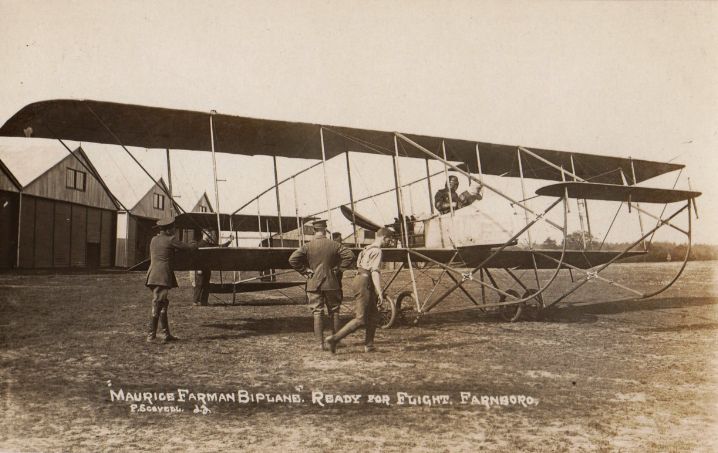
[Photo
by HampshireAirfields.co.uk]
By April 1918 Lieutenant Bellamy was a Technical
Officer stationed
at
East
Fortune RNAS, just outside of
Edinburgh.
He was later promoted as Captain, Royal Air Force.
In 1918, a prototype Sopwith Snipe was trialled at East Fortune and
after acceptance, the type was introduced to the Torpedo Aeroplane
School at the base.
In 1919 the
British
airship R34 made the first ever
return flight
across the Atlantic and the first east-west crossing by air, flying
from East Fortune to Mineola, New York.
After WW1 as a Chartered Electrical Engineer he became an
Associate of the Institute of Mechanical Engineers (A.I.M.E.).
In later life he worked for over 15 years in Malta for
British
Insulated and Helsby Cables Ltd
and became a Fellow of the
Institute of Electrical Engineers
.
According to brother Fenton Bellamy he would have liked to retire in
Malta but his wife wished to return to Liverpool.
Revill
passed away 1974
in Liverpool

All
Aliens RFC, Seft0n
RUFC
photographs, programmes and memorabilia Copyright © 2012
Sefton RUFC
